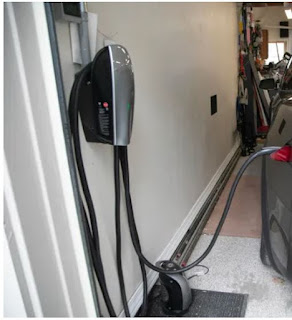Inspecting Electric Vehicle Charging Stations

As electric vehicle’s become more popular we are seeing more charging systems in garages and mounted outside. Some charging stations are supplied by a 240 Volt AC single-phase electricity source or 120 Volt AC to provide electricity to the vehicle’s charging system. There are three types of charging options: Level 1, Level 2, & Level 3. Level 1 chargers employ a standard AC current at 120 Volts and is supplied to the vehicle using a portable cord that plugs into standard 20 amp three prong outlet. Level 1 chargers provide 2-5 miles of electric range for each hour of charging. Level 2 chargers are a higher voltage at 240 volts and is supplied as AC current to the vehicle using a standard connector that works with most vehicles. (Tesla provides an adapter). Level 2 chargers provide about 20 miles of range in an hour. 3-6 hours usually provides a full charge. Level 3 charging is a bit different. First these 2 fundamentals of electric vehicle charging. 1. Power from the utility company is always alternating current (AC). 2. Electric vehicle batteries only accept direct current (DC). In level 1 & 2 charging the AC to DC conversion takes place in the vehicle in an onboard charger. With level 3 charging, the conversion takes place before the power reaches the vehicle inside the charging station. This bypasses the slower onboard charger and instead charges the battery directly. Normally you can charge a battery to 80% in 30 minutes. Level 3 charging stations are not currently available for home use as they use a 480 volt system.
Most charging stations are designed with a permanent grounding system to provide safety to the user. The charging station is wired similar to a sub panel. They are also GFCI equipped and will shut down if a fault is detected. This connection is typically at the utility entry power distribution panel. Most charging stations are designed to control and monitor energy delivery from the residence’s electrical service wiring to the electric vehicle. The vehicle monitors current and battery state of charge. What should a home inspector be looking for:
- The charging enclosure should be completely insulated with no exposed parts
- Check the charging cable for damage.
- The charging cable should not be in contact with the ground
- The charging station should be on a dedicated circuit
- The charging station should be connected to a grounded, metal, permanent wiring system
- An equipment-grounding conductor is to be run with the power circuit conductors and connected to an equipment grounding terminal or lead on the charging stations ground strip
- Corrosion / arcing / damage on the inside of the charging station
- The mounting plate and face unit must be used and securely fastened to the wall
- Most home charging stations are rated for 40 amps, however check with the manufacture
- The two phases must each measure 120 Volts AC to Neutral.
- There should be no exposed wires
- Earth ground must be connected to neutral at only one point.
- A service disconnect should be near the unit if it is not in close proximity to the service panel housing the service disconnect for the station (check local requirements)
- Four conductors should be used to supply the charging station (2-hot, 1-neutral, 1 ground)
Related Articles:
Want To Learn More? Click HERE to Search Our Full Database Of Home Inspector Newsletters.



